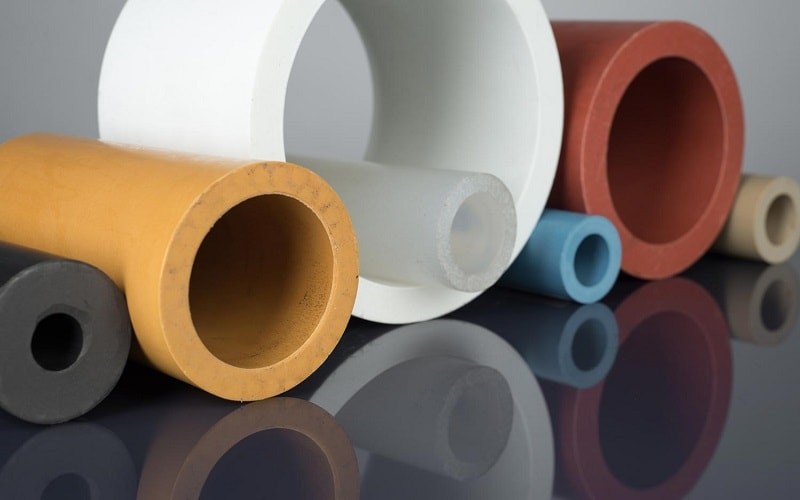
In the field of material science today, impact-resistant plastics have become a powerful alternative to metals. With advantages such as lightweight, durability, and design flexibility, these plastics are widely used in automotive manufacturing, electronics, medical devices, and security equipment. This article focuses on the five best-performing impact-resistant plastics: Polycarbonate (PC), Impact-Resistant Polypropylene (PP), Polyamide (Nylon), Ultra-High Molecular Weight Polyethylene (UHMWPE), and Polyether Ether Ketone (PEEK). Through detailed data comparisons, application case studies, and selection guides, engineers, designers, and procurement decision-makers can better understand the properties and advantages of these materials.
Molecular Structure: Benzene rings provide rigidity, while carbonate groups give toughness, creating a "flexible-rigid" molecular network capable of absorbing impact energy through localized orientation and displacement.
Key Data:
Impact strength is 250-300 times that of ordinary glass and 30 times that of acrylic (PMMA).
Notch impact strength of 600-900 J/m, light transmittance >90%, usage temperature range of -100°C to +135°C, density of 1.2-1.22 g/cm³.
Limitations: Relatively low surface hardness (Rockwell hardness M70), prone to scratching. Surface hardness can be enhanced to above 3H using siloxane coatings or UV curing treatments.
Automotive and Aerospace: Used in car headlights and Boeing 787 aircraft windows, which can withstand extreme pressure changes and external impacts.
Electronics: Hardened PC is used in smartphone camera lenses and screen protectors, combining drop resistance and optical clarity.
Medical: PC is used for surgical instrument trays and epidemic protection equipment due to its steam sterilization capability at 134°C.
Modification Techniques: Through copolymer modification and additives, the material forms an "island structure" that induces silver streaks and shear bands under impact, boosting impact resistance by 5-10 times.
Key Data:
Notch impact strength of 15-80 kJ/m², maintaining good toughness at -30°C, density of 0.89-0.91 g/cm³.
Melt Flow Rate (MFR) of 5-50 g/10min, lower processing temperatures by 20-30°C compared to engineering plastics, no need for pre-drying.
Automotive Parts: Modern car bumpers made from impact-resistant PP are 50% lighter, with better low-speed collision rebound characteristics and 40% lower repair costs. A mid-sized sedan uses 20-30 kg of impact-resistant PP, accounting for more than 30% of the total plastic material.
Packaging: Integrated hinge design allows thousands of open/close cycles without breaking; FDA certified for food containers.
Chemical Industry: Ultra-high molecular weight PP and glass fiber reinforced materials are used in corrosion-resistant equipment.
Molecular Structure: The amide bonds and methylene chain segments work synergistically, providing both hydrogen bond strength and maintaining molecular chain mobility. Notch impact strength is 50-100 kJ/m², 2-3 times that of ABS.
Key Data:
Nylon 12 maintains 70% of its impact strength at -60°C, suitable for polar equipment.
Processing moisture content must be <0.2%; PA6 injection temperature 230-260°C; PA66 injection temperature 270-290°C.
Automotive Industry: Nylon 12 fuel lines withstand fuel pulses and stone impacts. Turbocharger ducts use PA66/6T resistant to 140°C. Fiber-reinforced nylon for intake manifolds reduces weight by 50% and noise.
Sports Equipment: Ski binding parts require precise balance between protection and release, making nylon an ideal choice.
Molecular Structure: With molecular weights of 2-6 million, the polymer chains are entangled and absorb energy through untangling and sliding. Impact strength reaches 150-200 kJ/m², 8 times stronger than carbon steel.
Key Data:
Friction coefficient of 0.1-0.2 (similar to PTFE), very low wear rate, ideal for unlubricated bearings.
Gel-spun UHMWPE fiber strength reaches 3-4 GPa (15 times that of steel).
Safety Protection: UHMWPE is 30% lighter than Kevlar with 30% improved protection performance; 5 mm thick UHMWPE plates absorb 90% of grenade fragment energy; 20 layers of UHMWPE fabric block 85% of .22 caliber bullet energy.
Medical Implants: High-crosslink UHMWPE (ArCom®) for artificial hip cups improves wear resistance by 10 times and lasts over 20 years.
Industrial: The Three Gorges Dam sluice gate bearings have a lifespan of 50 years.
Molecular Structure: Ether bonds provide toughness, ketone groups impart rigidity, and benzene rings ensure stability. PEEK maintains stable performance at temperatures up to 260°C with a notch impact strength of 8-10 kJ/m².
Key Data:
Carbon fiber reinforcement (30%) increases tensile strength to 200 MPa and modulus to 20 GPa.
Processing melt temperature of 370-400°C, mold temperature 160-200°C, requiring drying >24 hours under vacuum with moisture content <0.02%.
Aerospace: Airbus A350XWB’s body frame is 30% lighter than aluminum. Jet engine bearing retainers withstand 400°C temperatures and vibration.
Medical Implants: PEEK intervertebral fusion devices match bone elasticity, avoiding "stress shielding" effects. Bone plates' impact strength is 80% that of stainless steel, reducing secondary fracture risks.
| Performance Indicator | PC | Impact-Resistant PP | Nylon | UHMWPE | PEEK |
| Notch Impact Strength (kJ/m²) | 60-90 | 15-80 | 50-100 | 150-200 | 8-10 |
| Maximum Usage Temperature (°C) | 135 | 120 | 150 | 100 | 260 |
| Density (g/cm³) | 1.20-1.22 | 0.89-0.91 | 1.13-1.15 | 0.93-0.94 | 1.32 |
| Cost Index | 1.5-2.0 | 1.0 | 1.8-2.5 | 2.5-3.5 | 8-10 |
Transparent Parts: PC (light transmittance >90%) or PETG (cost-effective alternative).
Automotive Exterior: Impact-resistant PP (low cost and easy to spray).
Engine Compartments: Nylon or PEEK (high-temperature resistance).
Bulletproof Protection: UHMWPE (best energy absorption).
Medical Implants: UHMWPE or PEEK (biocompatibility).
Nano-Enhancement: Carbon nanotubes make PC smartphone casings pass 1.8-meter drop tests at 0.8 mm thickness.
Bio-based Materials: Castor oil-based nylon 610 reduces carbon footprint by 50%.
Smart Materials: Shear-thickening fluids (STF) instantly harden upon impact.
Hybrid Systems: Metal/plastic composite laminates balance rigidity and energy absorption.
By deeply understanding the properties, applications, and selection strategies of these five impact-resistant plastics, product designers and engineers can match the best material solutions to specific needs, creating safer, more durable, and cost-effective products. With ongoing advancements in material science, the performance boundaries of impact-resistant plastics will continue to expand, bringing more innovative possibilities to industries worldwide.